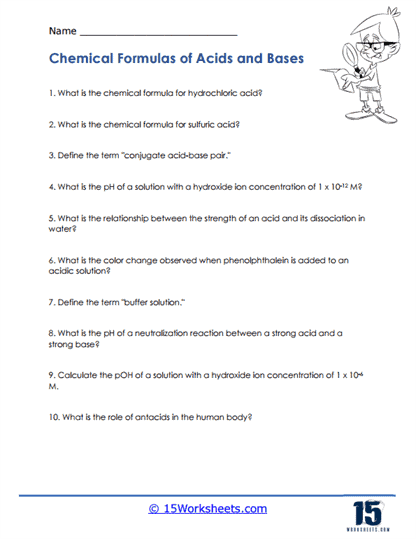Chemical Formulas of Acids and Bases

Worksheet Description
The worksheet is a tool for assessing and deepening understanding of acid-base chemistry. To excel, students should blend theoretical learning with hands-on application, ensuring a well-rounded grasp of the material.
It encompasses a range of topics from the chemical formulas of specific acids to concepts like conjugate acid-base pairs, buffer solutions, and the physiological role of antacids.
The worksheet seeks to:
Recognize and state the chemical formulas of common acids.
Understand acid-base interactions, such as conjugate pairs and neutralization.
Grasp the concepts of pH, pOH, and the strength of acids.
Recognize the importance of buffer solutions and antacids.
Concept Explanation
Chemical Formulas – Chemical formulas represent the composition of a compound. For example, the chemical formula for water is H₂O.
Conjugate Acid-Base Pairs – This refers to a pair of substances related by the loss or gain of a single proton. For instance, when an acid donates a proton, it becomes its conjugate base.
pH and pOH – These are measures of the acidity or basicity of a solution. The pH scale ranges from 0 (very acidic) to 14 (very basic), with 7 being neutral.
Strength of Acids – This pertains to the extent to which an acid dissociates in water. A strong acid, for instance, fully dissociates.
Indicators – Substances like phenolphthalein change color in response to pH, signaling the acidic or basic nature of a solution.
Buffer Solution – A solution that resists significant changes in its pH when an acid or base is added.
Neutralization – A chemical reaction between an acid and a base, typically yielding water and a salt.
Antacids – Medications that neutralize stomach acid, alleviating heartburn and indigestion.
